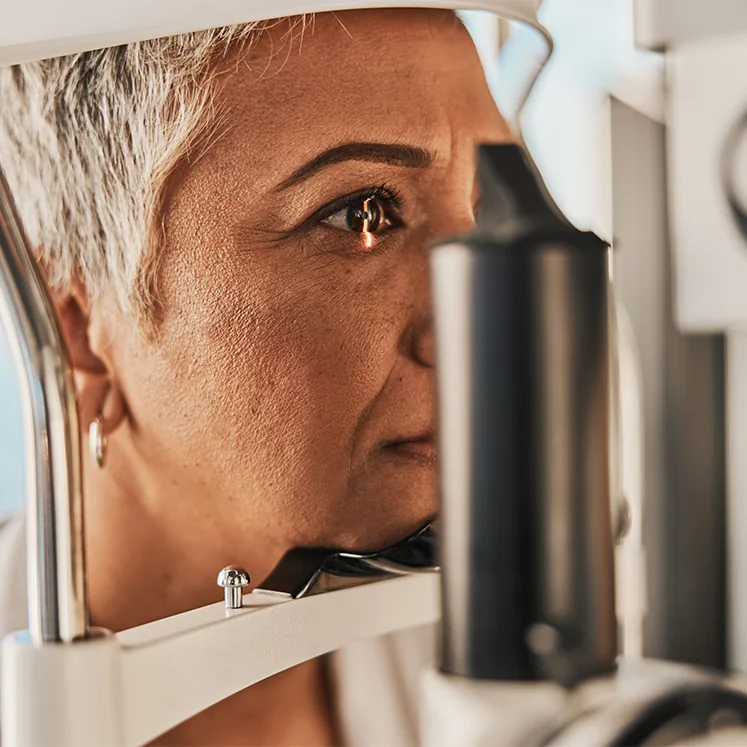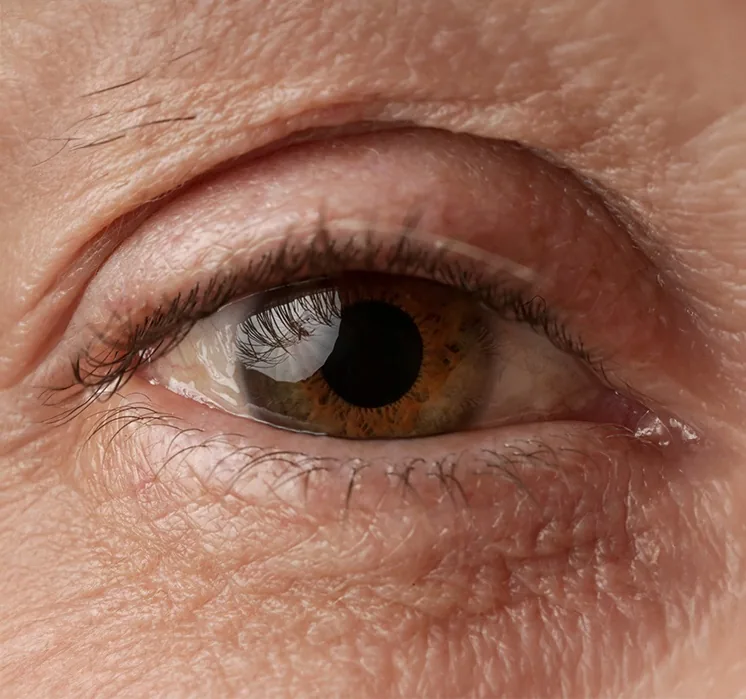Glaucoma
Glaucoma is a common eye condition that can lead to vision loss if not managed properly, but with early detection and treatment, long-term eye health can be maintained. At NY LASIK, we are one of the few ophthalmology practices with a surgical glaucoma specialist, Dr. Johnny Li, right here on our team. This means patients across NYC, Manhattan, Brooklyn, and New York can receive comprehensive glaucoma care without the need for referrals or outside specialists, ensuring seamless, expert management to protect your vision.

What is Glaucoma?
Glaucoma is a group of eye diseases that cause damage to the optic nerve, often due to increased intraocular pressure (IOP). This pressure builds up when the eye produces too much fluid, called aqueous humor, or when the fluid doesn’t drain properly through the eye’s natural drainage system. Over time, this elevated pressure harms the optic nerve, which transmits visual information to the brain.
Glaucoma affects over
Trusted Source
Don’t Let Glaucoma Steal Your Sight!
Centers for Disease Control and Prevention
Go to Source
3 million
Americans and is one of the leading causes of irreversible blindness worldwide. The disease often progresses without symptoms, earning it the nickname “silent thief of sight.” Vision loss typically begins with peripheral vision and can ultimately lead to blindness if left untreated. Early detection is critical to preserving vision and quality of life.
Contact us to learn more about how we can help manage your glaucoma and protect your vision.

Types of Glaucoma
There are several types of glaucoma, with the two most common being open-angle and closed-angle glaucoma. Each type affects the eye differently and requires specific management.
Open-Angle Glaucoma
The most prevalent form, open-angle glaucoma, occurs when the eye’s drainage system, known as the trabecular meshwork, becomes inefficient. While the fluid, or aqueous humor, has access to the drainage channels, it doesn’t drain effectively, causing pressure to build inside the eye. This gradual increase in pressure can damage the optic nerve, leading to vision loss. Open-angle glaucoma is often symptomless in its early stages, making routine eye exams essential for detection.
Closed-Angle Glaucoma
Closed-angle glaucoma, also referred to as angle-closure or acute glaucoma, is a more severe but less common form. In this type, the angle between the iris and the cornea becomes too narrow, blocking fluid from draining properly. This leads to a rapid increase in eye pressure, causing sudden symptoms like severe eye pain, headaches, blurred vision, and nausea. Closed-angle glaucoma is considered a medical emergency and requires immediate treatment to prevent permanent vision loss.
Low-Tension Glaucoma
In some cases, optic nerve damage can occur even without elevated intraocular pressure. This condition, known as
Trusted Source
Types of Glaucoma
National Eye Institute
Go to Source
low-tension
or normal-tension glaucoma, is less understood but still results in progressive vision loss. Even without high eye pressure, damage to the optic nerve continues, necessitating early detection and management.
Each type of glaucoma can cause irreversible damage if left untreated, which is why regular eye exams and early diagnosis are key to preserving vision.

Symptoms of Glaucoma
Glaucoma is often referred to as the “silent thief of sight” because it typically progresses without noticeable symptoms, especially in its most common form, open-angle glaucoma. Many individuals may not realize they have the condition until significant vision loss has already occurred. In the early stages, vision loss is gradual and painless, making it easy to overlook. This is why routine eye exams are crucial for early detection.
In more advanced stages or in rare cases of closed-angle glaucoma, symptoms may be more immediate and severe. These can include:
- Sudden eye pain or pressure
- Headaches
- Red eyes
- Blurred vision
- Seeing rainbow-colored halos around lights
- Nausea or
Trusted Source Glaucoma Cleveland Clinic Go to Source vomiting
If any of these symptoms occur, especially during a “glaucoma attack,” it should be treated as a medical emergency to prevent permanent damage. Early detection and prompt treatment are essential to preserving vision and preventing further damage.
Book an appointment
Book an appointment now for expert glaucoma care with our specialist.

What Causes Glaucoma?
Glaucoma is typically caused by increased pressure within the eye, known as intraocular pressure. This pressure results from an imbalance in the production and drainage of the eye’s natural fluid, leading to damage to the optic nerve. However, elevated pressure is not the only risk factor. In some cases, patients with normal eye pressure can still develop glaucoma, indicating that other factors may also contribute to the disease. Routine eye exams are essential for early detection and to identify potential risk factors, regardless of whether intraocular pressure is elevated.
How is Glaucoma Diagnosed?
Glaucoma is diagnosed through a series of non-invasive tests designed to evaluate eye pressure, optic nerve health, and peripheral vision. During a routine eye exam, your doctor may use a test called tonometry to measure intraocular pressure, which can be elevated in glaucoma cases. A dilated eye exam allows the doctor to get a closer look at the optic nerve to identify any signs of damage.
If glaucoma is suspected, additional testing may be recommended. These tests can include Optical Coherence Tomography (OCT) to measure the thickness of the retinal nerve fiber layer, a visual field test to assess peripheral vision, and gonioscopy to evaluate the drainage angle in the eye. Early diagnosis through these screenings is essential to prevent vision loss and manage the condition effectively.

Glaucoma Treatment
Glaucoma treatment focuses on managing intraocular pressure to prevent further damage to the optic nerve and slow the progression of the disease. While there is no cure for glaucoma, there are several effective treatments available that can help protect vision.
Medications
For many patients, medicated eye drops are the first line of defense. These drops help reduce intraocular pressure by either decreasing the production of fluid in the eye or improving the drainage of fluid. Although eye drops won’t reverse damage, they can slow the progression of the disease if used consistently. In some cases, oral medications may be prescribed in addition to or instead of eye drops.
Laser Treatment
Selective Laser Trabeculoplasty (SLT) is a minimally invasive option that may be recommended if medications are not sufficient to control eye pressure. SLT uses laser energy to target the drainage system in the eye, helping it to function more effectively. This procedure is quick, painless, and can reduce the need for long-term medication. SLT may provide pressure relief for several years but can be repeated if necessary.
Minimally-Invasive Glaucoma Surgery (MIGS)
When glaucoma progresses despite the use of medications or laser treatments, minimally-invasive glaucoma surgery (MIGS) offers an innovative and effective solution. MIGS procedures are designed to reduce intraocular pressure by improving fluid drainage in the eye with minimal disruption to surrounding tissues. These surgeries are generally quicker and involve fewer risks than traditional glaucoma surgeries, resulting in a faster recovery time and less dependence on ongoing medication. MIGS is often recommended for patients with mild to moderate glaucoma and can significantly reduce the need for more invasive procedures down the road while enhancing long-term eye health and comfort.
Traditional Glaucoma Surgery
For advanced glaucoma or cases where other treatments have been ineffective, traditional surgical procedures such as trabeculectomy or tube shunt surgery may be required. Trabeculectomy creates a new drainage channel to lower pressure, while a tube shunt places a small flexible tube in the eye to redirect fluid. Both procedures aim to prevent further vision loss by controlling pressure inside the eye.
Schedule a consultation
Schedule a consultation today to discuss your glaucoma treatment options.
Anyone can develop glaucoma, but certain individuals are at a higher risk due to specific factors. Regular eye exams are crucial for early detection, especially if you fall into one or more of the following categories:
- Age: People over 60 are at a higher risk, with the likelihood increasing each year.
- Race: African Americans are more likely to develop glaucoma at a younger age and with greater severity. People of Asian descent have a higher risk of angle-closure glaucoma, while those of Japanese descent are more prone to low-tension glaucoma.
- Family History: Having a close relative, such as a parent or sibling, with glaucoma significantly raises your risk.
- Medical Conditions: Diabetes, high blood pressure, and other conditions like migraines or sickle cell anemia can increase your chances of developing glaucoma.
- Eye Injuries or Surgery: Previous eye trauma or surgery can damage eye structures, leading to elevated intraocular pressure.
- Medications: Long-term use of corticosteroids, such as prednisone, may elevate eye pressure and contribute to glaucoma.
- Vision Conditions: High myopia (extreme nearsightedness) and hyperopia (farsightedness) have been associated with an
Trusted Source Glaucoma Mayo Clinic Go to Source increased risk
of glaucoma, even in patients who have undergone corrective procedures like LASIK.
Understanding your risk factors and scheduling regular eye exams are key steps in preventing vision loss from glaucoma.
While glaucoma can’t always be fully prevented, you can lower your risk with regular eye exams and early detection. Staying active, managing conditions like high blood pressure and diabetes, wearing UV protective sunglasses, and knowing your family history can also help protect your eyes and preserve your vision.
There is no cure for glaucoma, but treatment focuses on lowering eye pressure to prevent further vision loss. This is often done with eye drops, and in some cases, laser treatments or surgery may be recommended.
The cost of glaucoma treatment varies depending on the type of treatment and your insurance coverage. Since glaucoma treatment is considered medically necessary, most health insurance plans cover a portion of the costs. Your out-of-pocket expenses will depend on your individual needs and the specific treatment plan recommended.
1 Centers for Disease Control and Prevention. Don’t Let Glaucoma Steal Your Sight! Accessed September 10, 2024.
2 National Eye Institute. Types of Glaucoma. Available: https://www.nei.nih.gov/learn-about-eye-health/eye-conditions-and-diseases/glaucoma/types-glaucoma. Accessed September 10, 2024.
3 Cleveland Clinic. Glaucoma. Available: https://my.clevelandclinic.org/health/diseases/4212-glaucoma. Accessed September 10, 2024.
4 Mayo Clinic. Glaucoma. Available: https://www.mayoclinic.org/diseases-conditions/glaucoma/symptoms-causes/syc-20372839. Accessed September 10, 2024.
Dr. Leonard Bley has either authored or reviewed and approved this content.